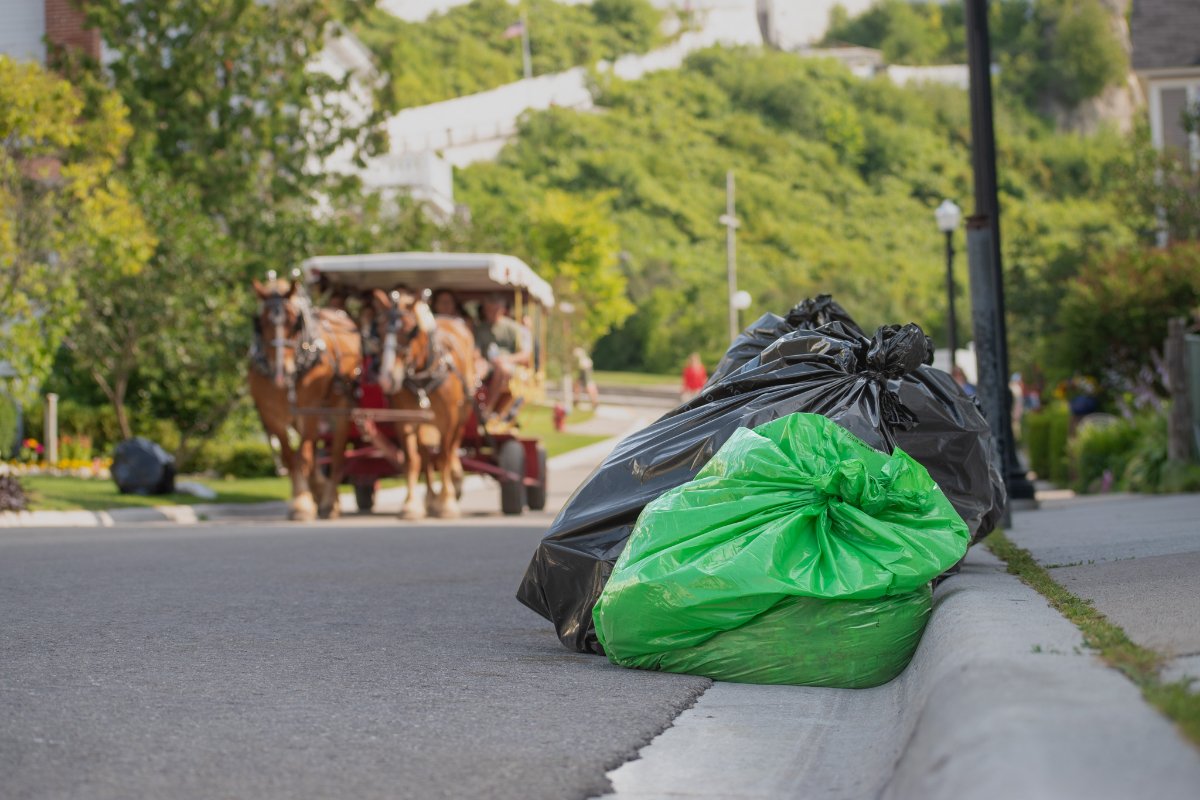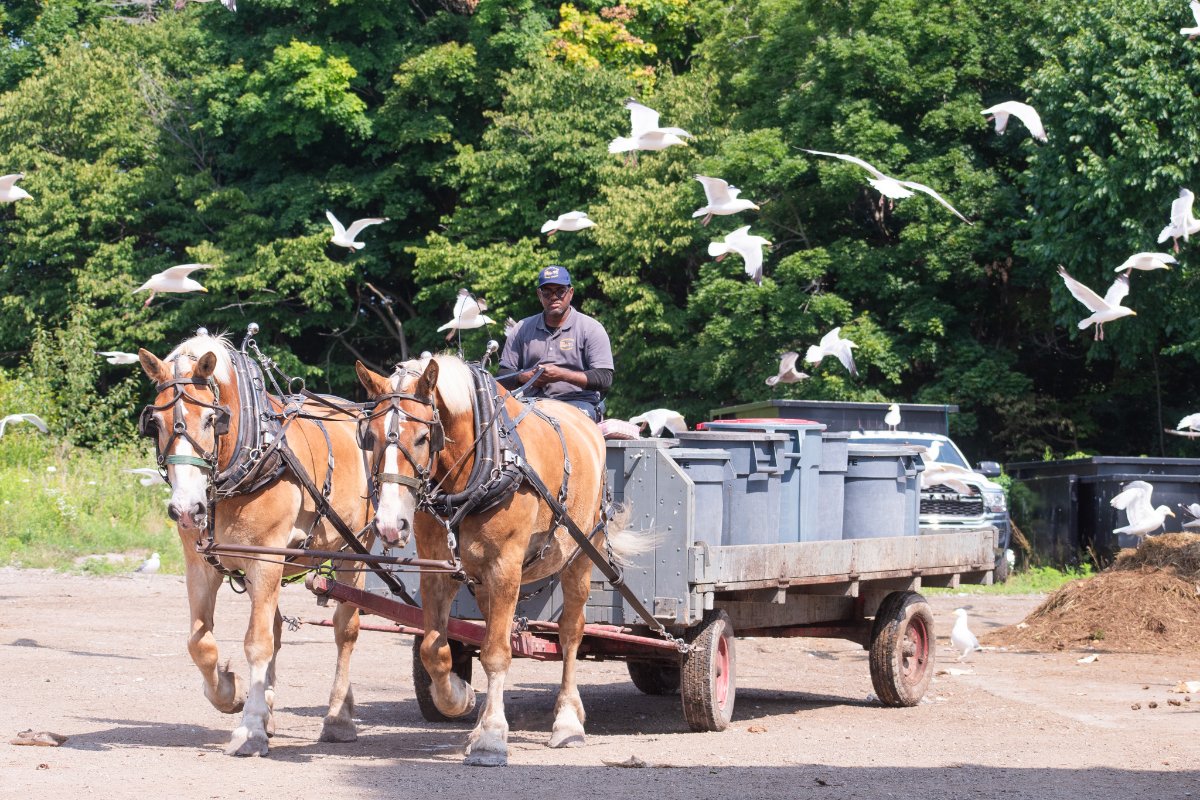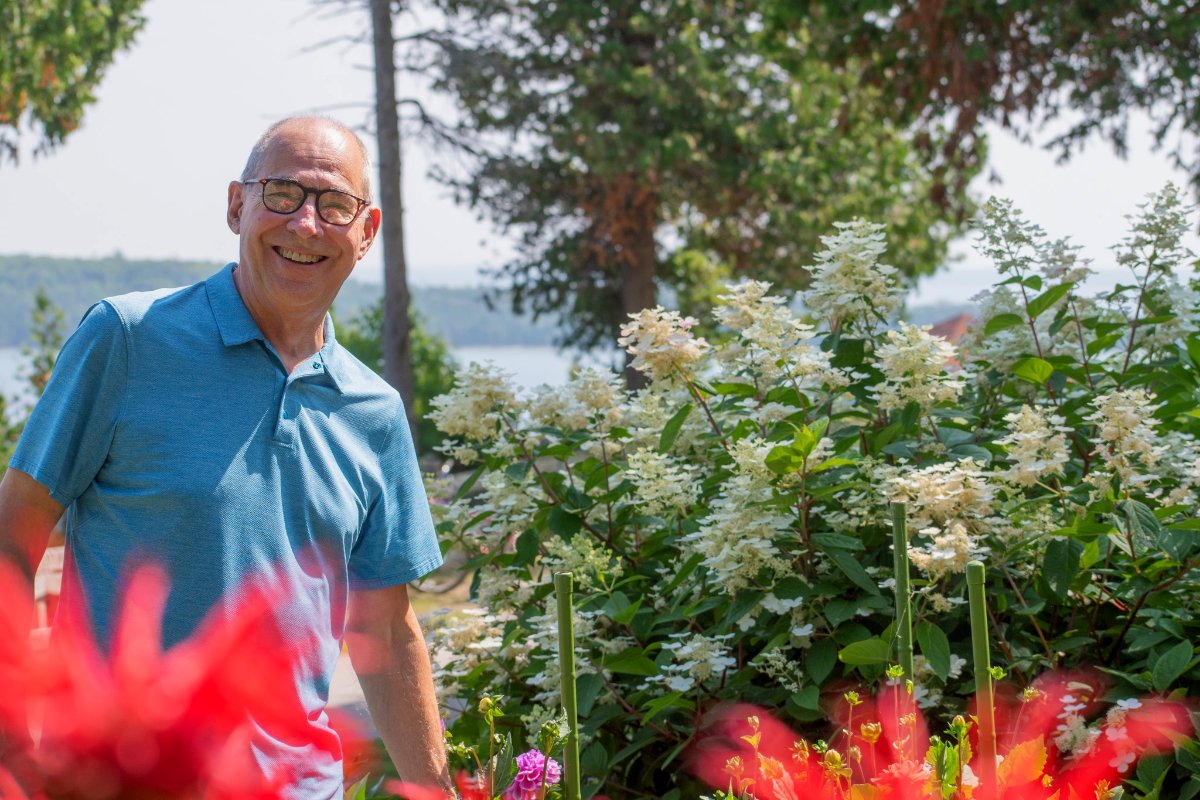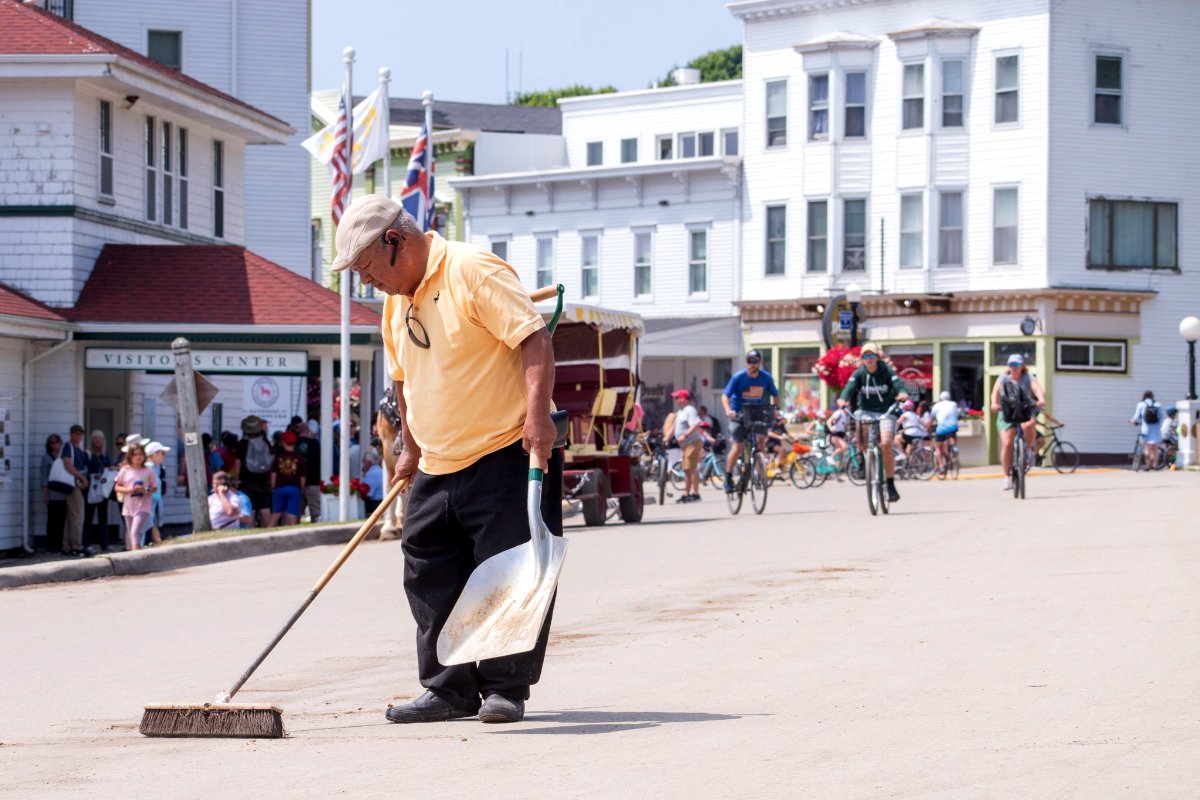The isolated, vehicle-free Great Lakes community has a lot to teach other communities about managing food waste.

The isolated, vehicle-free Great Lakes community has a lot to teach other communities about managing food waste.
October 23, 2023

Mackinac DPW sells green compost bags at a cheaper rate than the black bags for trash. (Photo credit: Paige Hodder)
On a hot July day on Michigan’s vehicle-free Mackinac Island, people swarm the downtown streets on foot and bikes and in horse-drawn carriages. Sitting high atop a cart emblazoned with the mission of “Keeping Mackinac Beautiful,” a city sanitation worker maneuvers a two-horse team through the fray, stopping periodically to collect trash and compost.
This iconic Great Lakes vacation spot has been running a composting program since the 1990s. Tourists often stop to gawk at the novelty of a horse-drawn garbage cart—and many look no further than that. But a closer look reveals far more than a gimmick: Mackinac’s system of small-town composting has been in place for decades and now thrives despite its limitations.

A worker drives the slop wagon after delivering waste to the solid waste facility. (Photo credit: Paige Hodder)
More and more communities across the U.S. are adopting composting each year. New York City recently made national headlines with its curbside composting program, and California has pushed forward mandatory composting regulations that target emissions. As these kinds of initiatives spread, this small town provides an example of what a successful, decades-old composting program can look like.
The island is uniquely situated off Michigan’s Upper Peninsula in the northernmost tip of Lake Huron. In the winter, the surrounding waters can freeze, leaving roughly 400 year-round residents almost entirely cut off from the mainland.
The island’s community is defined by its quiet character and dedication to historical legacy—non-essential motor vehicles have been banned since 1898. In the summer, the population swells with thousands of seasonal employees, summer residents, and tourists. And with the increase in population comes a swell of waste.
Because of the island’s isolation and lack of motor vehicles, moving waste to the mainland is logistically and financially taxing, explained Allen Burt, director of the Mackinac Department of Public Works (DPW). As such, any effort to reduce that waste is critical.

Long-time summer resident Tom Lewand said composting has become second nature for this family. (Photo credit: Paige Hodder)
Long-time summer resident Tom Lewand has become quite accustomed to the composting system. “It becomes second nature up here,” he said. “Even our youngest grandkids learn the system at a very young age, and know what goes in the green bag and what goes in the black bag.”
At the island’s solid waste facility—hidden away in the hills and surrounded by forestland—piles of food scraps, manure, and green waste slowly turn to soil.
Composting programs are becoming more common, but they are still primarily concentrated in urban areas that have the infrastructure to support the process, according to Linda Norris-Waldt, deputy director of the U.S. Composting Council.
In rural areas, “It is not always cost feasible to go from house to house to collect compost because they are miles away,” she explained. Backyard and farm composting by individuals can be more common in these areas, she added.

Workers collect horse manure by bike along the streets of downtown Mackinac Island. (Photo credit: Paige Hodder)
Almost 50 percent of all full-scale food waste composting facilities are located in just seven states—California, New York, Colorado, Pennsylvania, Washington, Texas, and North Carolina, according to a study from BioCycle. In contrast, the central, Mountain, and Southwest states are considered “composting deserts,” Norris-Waldt said. The Midwest lies somewhere in the middle between these barren regions and the coasts.
Nationally, yard waste composting is more common than food waste composting, which is costlier and more labor intensive, Norris-Waldt said. The same study from BioCycle surveyed 105 facilities and found that more than two-thirds of food waste operations were built in the last two decades.
Most programs begin using a subscription model instead of mandatory sorting, Norris-Waldt added. Mandatory sorting is difficult because a lack of widespread public knowledge on proper sorting can lead to higher levels of contamination, she explained.
Mackinac began composting in the 1990s, predating the recent spike in food-waste programs, just as the island’s onsite dumps were set to close. Burt doesn’t know exactly why the dumps were capped, but he suspects it was due to capacity and groundwater contamination concerns. Now, islanders ship landfill material to the mainland.
In the years since the dumps closed, composting has become a part of life for island residents and businesses. While sustainability and climate-consciousness drives composting efforts nationwide, for islanders, the benefits of the waste management system extend further.
Mackinac residents and visitors collect paper products, kitchen scraps, and manure in green compost bags that are sold by Mackinac DPW. The green bags cost only $2, while the trash bags cost $4.50, to encourage residents to sort as much as possible.
A horse-drawn wagon called a “dray” then picks up compost on the same schedule as trash, and a separate “slop wagon” comes around to the island’s two large hotels during the summer to collect kitchen waste, said Gabe Cowell, the island’s solid waste facility manager.
Once waste is collected, city workers drive it uphill to the solid waste facility, where there are six bays processing two piles of compost each. The task is significantly reduced in scale during the winter, with only one or two bays in use and tarped to maintain the heat. Cowell mixes the compost piles almost every morning and moves the piles in the bay once a week.
Since horses provide transportation on the island, Mackinac compost contains a lot of manure. “We go from a herd of probably 15 to 20 horses in the winter to over 600 in the summer,” said Burt. “The waste material they produce is drastically bigger.” Horse droppings are quickly whisked away, contributing up to 40 to 60 yards of manure to the solid waste facility a day from June through September.
The compost processes for about a month before it is sifted and shredded. Meanwhile, businesses and residences can place orders at $10 a yard. Then, about every six months, workers distribute the compost throughout the island.
Compost adds organic matter to soil, making it more resilient during both droughts or floods, Norris-Waldt said. In the case of Mackinac, the rich soil has become the community’s solution to the island’s rocky topography. “Mackinac has next to no topsoil, especially [in the residential areas]. It’s mostly beach gravel,” Burt said. “So, if you want a lawn or garden, you need topsoil.”

The topsoil made from compost on Mackinac is used in gardens at personal residences and businesses around the Island. (Photo credit: Paige Hodder)
When Lewand and his family first began to visit in the early 1970s, residential gardens were sparse. But in the years since the program began, composting has quite literally changed the island’s landscape.
Now retired, Lewand maintains a flower garden at his summer residence overlooking Lake Huron, overflowing with vibrant green foliage interspersed by red monardas and purple dahlias. The garden is typical of Mackinac’s famous summer cottages lining its east and west bluffs.
In addition to feeding the soil, composting programs can provide communities with an economic boost, offering trickle-down benefits and good employment opportunities, Norris-Waldt explained. Mackinac employs a four-person solid waste facility team in the summer, while some resorts and hotels on the islands have entire teams dedicated to waste management.
“The bigger a business gets, the more people you need dedicated to trash all the time,” Burt explained.
Composting is not without its challenges, however, and Mackinac is no exception. For example, contamination is one ongoing obstacle facing composting programs across the U.S. The main sources of compost contamination are persistent herbicides, non-compostable trash, and PFAS, according to the composting council. Contamination can be combated by education and communication efforts in communities, Norris-Waldt said, both between compost facilities and compost contributors and also businesses and their employees.
“Every facility has very specific situations and rules about what they can take,” Norris-Waldt said. “So, communities and programs really have to be tuned in to the compost manufacturer to find out what they can take to make their program work.” Beyond that, it often takes time, training, and prolonged commitment to get communities “to embrace composting as a business and allow it to exist and flourish.”
Last year, for instance, the Mission Point Resort staff realized they did not fully understand the solid waste facility’s process and timing, and that this gap in knowledge was impacting their ability to collaborate. Mission Point collects cardboard and manure for compost and also sends a slop wagon with scraps from its many restaurants to the solid waste facility every other day. But the resort staff had become frustrated by gaps in service.
Their proposed solution: informational tours of the facility for key staff members.
“We wanted to understand what we could do differently, and what we could do to help,” said Stan Antkoviak, the resort’s director of facilities. Mackinac DPW showed the resort just how long it took their small crew to unload cardboard and Mission Point Resort ultimately bought a cardboard bailer to make the process more efficient.
Both parties considered the tours a massive success. Now, the recycling manager at the resort holds yearly seminars on best practices for staff members and always tries to make herself available for questions.
Sarah Ombry, public relations and marketing manager at Mission Point, said that by “communicating about waste management in layman’s terms,” the recycling team has made composting and recycling “just a part of the routine.”
Employee investment is just as important further along in the composting process, Burt said. For him and the solid waste facility team, this has meant centering collaboration. “I can make all of the executive decisions, but it’s the staff on the ground that is making daily decisions,” he explained. “Any process changes need to be developed with the staff; otherwise, it’s just not going to work the way you think it will.”
Though it has taken years, Mackinac Island has overcome some common obstacles in establishing its composting program and making it a normal part of everyday life.
Mackinac DPW still faces a number of challenges toward maintaining and optimizing the composting process, including the cost of equipment and need to adapt to policy changes. To that end, Burt recommends continuous education and keeping an eye on what’s happening in other communities.
“It’s not glamorous and it’s not usually a lead headline, but it’s definitely worth putting a lot of energy into learning what is new, what other people are doing, and how they’re handling the same issues you are,” he said.

October 9, 2024
In this week’s Field Report, MAHA lands on Capitol Hill, climate-friendly farm funding, and more.
October 2, 2024

October 2, 2024

October 1, 2024

September 30, 2024

September 25, 2024

September 25, 2024

Like the story?
Join the conversation.